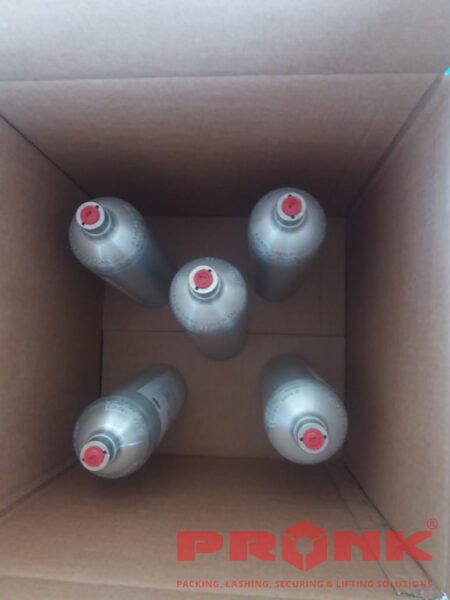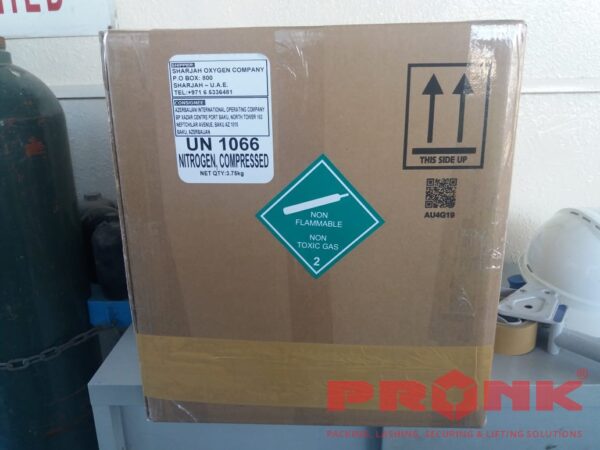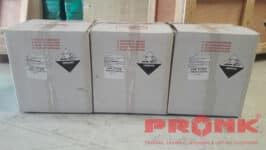Dangerous Goods Packing (DGP)-The Best way to Ship Dangerous Goods
What are Dangerous Goods Packing?
Dangerous goods are substances and articles having toxic, corrosive, explosive, flammable, and infectious properties. These are hazardous to public safety, property, and the atmosphere. Dangerous goods packing are the additional packaging components required for performing containment and safety procedures.
Transportation of DGP happens through road, river, air, rail, or sea. Being one of the leading packaging companies in India, we provide top-notch Packing Solutions.
Types of Dangerous Goods Packing
Here are the different types of dangerous goods –
Class 1: Explosives

Division 1.1: Substances and articles with a mass explosion hazard
Division 1.2: Substances and articles with a projection hazard but no mass explosion hazard
Division 1.3: Substances and articles with a blast hazard, fire hazard, and a projection hazard or its combination but no mass explosion hazard
Division 1.4: Substances and articles with no significant danger
Division 1.5: Insensitive substances with a mass explosion hazard
Division 1.6: Substances with no mass explosion hazard
Class 2: Gases
Division 2.1: Flammable gases
Division 2.2: Non-toxic and non-flammable gasses
Division 2.3: Toxic gases
Class 3: Flammable liquids
Class 4: Flammable solids
Division 4.1: Solid desensitized explosives, flammable solids, and self-reactive substances
Division 4.2: Substances likely to have unexpected combustion
Division 4.3: Substances radiating flammable gases with water
Class 5: Oxidizing substances
Division 5.1: Oxidizing agents
Division 5.2: Organic peroxides
Class 6: Toxic substances
Division 6.1: Toxic substances
Division 6.2: Infectious substances
Class 7: Radioactive material
Class 8: Corrosive substances

Class 9: Miscellaneous Dangerous Substances
Packing Group I: Substances with massive danger
Packing group II: Substances with medium danger
Packing group III: Substances with less hazard
Here are the best ways to ship the Dangerous Goods Packing –
Alternative 1: Based on transportation modes
1. Road
Hazardous Substances-Classification, Packaging and Labelling rules & Central Motor Vehicles Rules demonstrate the practices for goods transportation via road.
2. Air
(IATA)-International Air Transport Association has all the standard airline recognized provisions for carrying DGP through the air. It demonstrates the forbidden goods, operator responsibilities, storage & transport volumes.
3. Sea
The (IMSBC)-International Maritime Solid Bulk Cargoes Code carries all the mandatory provisions for carrying 3500+ packed dangerous goods in gas, liquid & solid form through the sea. Their objective is to stop marine pollution, safeguard human life, and stimulate the free motion of dangerous goods in packed form.
4. Barge
The Inland Waterway Authority of India has regulations like Shipping Regulations, National Waterways, and Safety of Navigation for DGP movement in India.
5. Rail
The Indian Railways Conference Association (IRCA) Red Tariff is responsible for transferring dangerous goods in India. Its provisions comprise caution labels pasting on wagon doors. Moreover, by using special lead seals for inflammable, oxidizing wagons carrying explosives and gases substances.
Alternative 2: Based on the shipping process stages,
1. Packaging
Dangerous goods are hazardous to humans. Use air-tight, sustainable packaging to keep the products safe.
2. Labeling

Placards, markings, and labels are a legal requirement for goods transfer & need to be carefully defined as they demonstrate that the box has hazardous items. Placards are put on containers, trucks, and cylinders. Markings comprise specifications, UN number, weight, PSN, precautions, and emergency treatments.
3. Documentation
Put in the correct information to have accurate handling of the product. It includes the exporter’s details, Hazard class, TREM, UN number, Container Packing Certificate, goods weight & quantity, PSN, packaging number & type.
4. Segregation
The IMDG Code specifies the ways to separate two or more incompatible substances. Take care of the following:
Avoid storing various explosives.
Avoid storing a strong concentrated acid that has a powerful alkali.
Avoid storing entities that have a fire risk and oxidizing agents.
Dangerous goods should have high-quality Packing Materials to overcome the loading & shocks during transportation. Get utmost satisfaction by availing of our packing solutions that use supreme-level packing materials.


